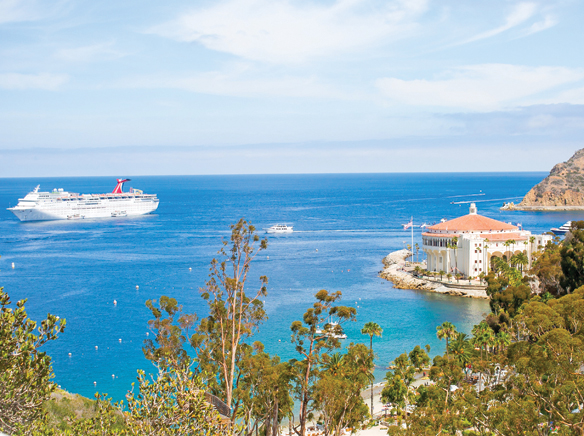Editor’s note: Jim Luttjohann is president and CEO of the Catalina Island Chamber of Commerce.
Recently a ship’s agent reached out to Avalon city representatives seeking dates to visit the port of Avalon. The ship’s agent, representing Royal Caribbean, requested Saturday and Tuesday visits for the period of July-September beginning in 2021. After weighing the time of year and days of week, the City representative responded that based on current demands, the only days of the week between July and September that harbor facilities could absorb tendering operations were Wednesdays or Thursdays. Wednesdays were offered to the ship’s agent for consideration.
A Wednesday call would not negatively impact cross channel delivery/departure of passengers. A Wednesday July-Sep call by Royal Caribbean would take advantage of peak staffing in area facilities but not likely overwhelm them due to there being no other ship in port. By limiting the calls to Wednesdays, impacts on infrastructure were seen as negligible at 3,000 passengers over the course of six to eight hours. Cross channel carriers often bring far more than 3,000 additional passengers in a day due to added boats but are unlikely to add that many passengers on a Wednesday based on typical demand.
Impacts to businesses were seen as beneficial, especially with most operators reporting declining patronage and sales year-over-year. The decline is supported by City of Avalon revenue tracking including:
• Admissions Tax revenue has been down every month of 2019 and for the past 12 months showed a decline of 8.6%
• Harbor Use Fees revenues are down every month year-to-date for 2019 and nearly flat with last year on a 12 month basis
• Sales tax is also showing a decline of 7.2% for the past 12 months
Impacts to the visitor and resident experience were also seen as positive, in adding revenue to the coffers of all concerned through increased sales and work opportunities. Revenue from wharfage alone would grow by $234,000 in year one (13 calls x 3,000 passengers x $6 per person). If a ballot initiative to fund hospital construction is passed next November, pay down of hospital debt would accelerate due to the additional guests being assessed a temporary fee including cruise ship passengers. The Catalina Island Chamber & Visitors Bureau’s Tourism Supply and Demand study conducted in 2017, found that 84% of visitors stated they had no experience of overcrowding while on the island, including on summer cruise ship days.
Retailers and tour operators have reported increases up to 70% in revenue on cruise ship days vs. weekdays without a ship in port and most of those sales are taxable in one or more fashions (Sales tax, Admissions tax and Harbor Use Fees).
The peak year for number of ships calling on Avalon was 1992 @ 202 vs 2018 @ 106 (96 fewer ships). The peak year for cruise passenger counts was 2005 @ 293,700 guests who came to the island vs 2018 @ 261,451 (32,249 fewer guests). The peak year for cross channel ferry passengers was 1999 @ 716,104 vs 712,730 cross channel passengers in 2018 (down 3,374). The peak year for total in-bound passengers by both cruise and cross channel providers was 2017 @ just over 1 million.
July-September 2018 had an increase of 6% in cross channel Ferry passengers over the prior year, however year-to date for 2019 traffic is down by 7% through July. July-September 2018 had a decrease of 8% in cruise ship passengers over the prior year. For 2019 year-to-date through July cruise passenger counts are up only 1.2%
The 2021 estimated counts for passengers of the proposed 13 additional calls combined with projected growth in passengers on existing calls, is estimated at 300,050 vs 261,451 in 2018. That’s an increase of 14.7% or 38,599 passengers. That sounds like a lot, but compared to peak years of cruise visitation there would actually be fewer ships (-83 from peak) and a growth of only 6,350 guests on an annual basis.
For the past year, the Chamber & Visitors Bureau Cruise Committee has engaged in trying to fulfill a significant focus recommended in the Tourism Supply and Demand study conducted in 2017.
To seek business in need periods over existing high demand periods (weekdays throughout the year and all days in shoulder/off season periods) and to do so with the goal of attracting a higher spending demographic of visitors.
Note the past few years, August and September have had fewer visitors to the island and been poorer performing economically, due in large part, to earlier initiation of mainland school years.
While on its face the current exploration by the ship’s agent may sound like it falls outside those goals, in fact it does not. It provides weekday visitation by an upscale clientele in a period of need and is within a quantity that Avalon can easily absorb. Impacts on Avalon’s resources are minimal. Compared to overnight guests, a cruise ship visitor has at least one less meal and doesn’t use the water or sewer system as much as an overnight guest who eats out more, showers and has linens laundered.
A Catalina Island Resident and Business sentiment survey is currently being conducted by SMG and includes questions on housing, schooling, employment and both Government and Chamber & Visitors Bureau access. Among the visitor segments referenced are cruise ship visitors. The survey data is being tabulated and will soon be available for release.
Far and away, the largest carrier of current cruise ship visitors to the island is Carnival Cruise Lines which typically calls on the port of Avalon twice per week (Mondays and Tuesdays with up to 2,600 passengers per visit). Last year several smaller ships began calling on Avalon including National Geographic, MSC and Seven Seas.
Once onshore, the cruise ship visitors to the Island embark on a variety of activities that enrich our local economy to the tune of an estimated $23 million per year. The top five activities they enjoy are shopping (64.4%), Dining (54.1%), sightseeing (30.4%), going to the beach (29.6%) and renting a golf cart for a scenic drive (17.8%). All of these activities are revenue generating to our local businesses and the transactions are mostly taxable too. Of course 100% of those visitors use a tender to bring them ashore, so “wharfage” (the fee charged for transiting the wharf) is also generated. In 2018 wharfage from Cruise ship visitors generated just over $643,000 for the City of Avalon.
The top states of origin among existing cruise ship visitors to Catalina Island are California, Arizona and Utah. Among the Californians on board (71.1%), the passengers are predominantly from the greater Los Angeles area, followed by San Francisco Bay area and San Diego. Being regionally sourced means they have a great propensity for making a return visit to the island. In fact, 48.9% stated in a 2016 survey by Lauren Schlau Consulting, that they were extremely likely to return to the island in the near future. Nearly 75% of cruise ship visitors to the Island stated that it was their first time to visit.
That means that every time a cruise ship comes into port, the majority are first time visitors and that about ½ of them will return to the Island for another visit, usually staying overnight and contributing even more to our economy.
For more information on Catalina Island visitor spending and demographics, visit CatalinaChamber.com and click on Visitor Statistics.











